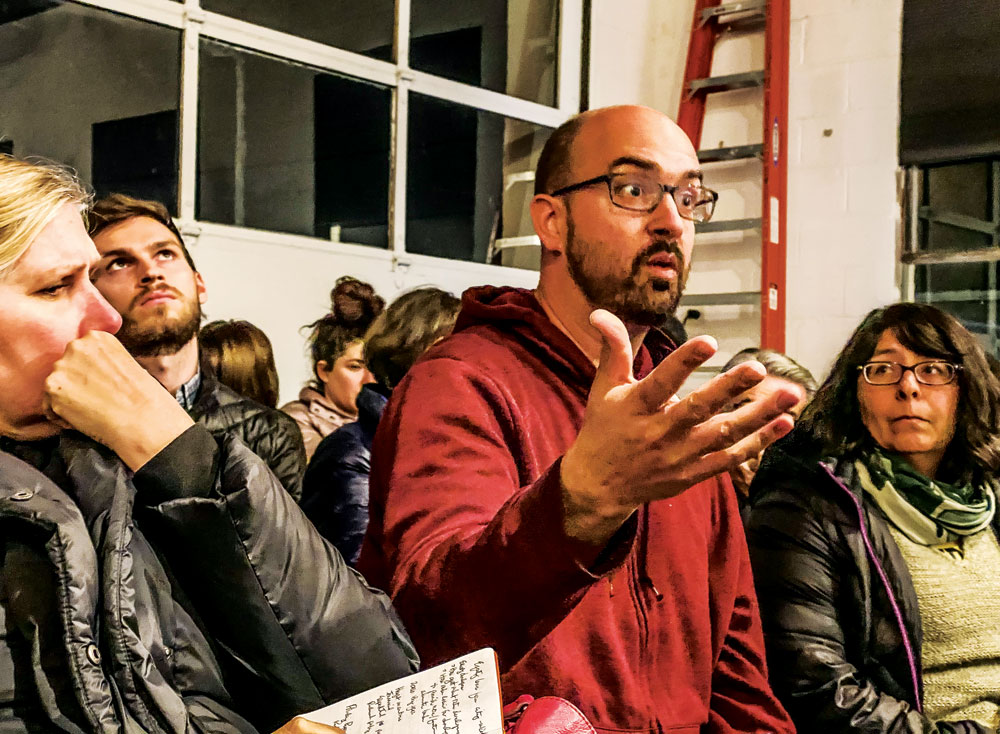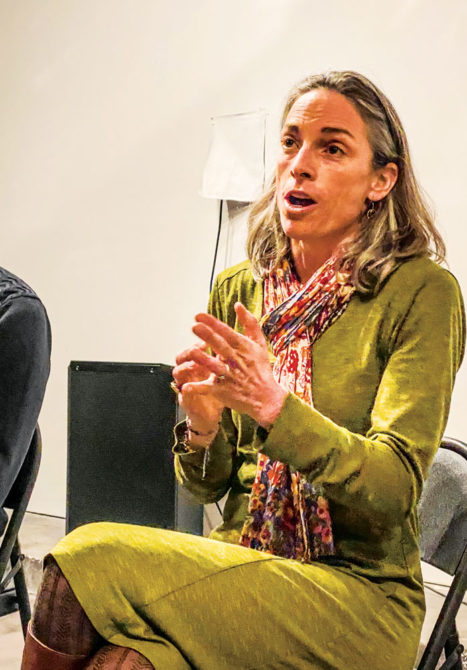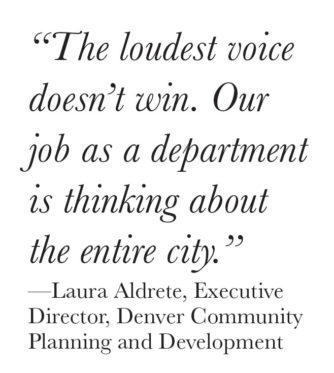
Brendan Greene with the E Colfax Community Collective speaks at a February 2020 meeting.

City planner Laura Aldrete, here responding to community concerns, has become the face of planning for the City of Denver since fall 2019.
“We know there is no silver bullet. Nobody has gotten it right,” says city planner Laura Aldrete, Executive Director of Denver’s Community Planning and Development (CPD) office, when asked what can be done to fix Denver’s housing crisis.
Delivering a range of housing options (“the missing middle”) is a high priority for CPD. To address the problem, CPD is currently looking at where duplexes, triplexes, rowhomes and other options can be added in single-family neighborhoods under current zoning. Builders would have to maintain the character of these neighborhoods by employing “similar architectural forms” while delivering a greater variety of housing options, says Aldrete.
Greater density is not always popular. East Area Plan (EAP) public meetings in particular, have included some vociferous debate over accessory dwelling units (ADUs) and increased housing density, including concerns over compromised parking and shifting demographics. “If you want to be able to control who lives next door to you, you should probably not live in the city of Denver,” says Aldrete. “There are communities in the suburbs that can give you that certainty. In a city committed to equity, we don’t believe that is our role.” She also believes City Council members, to ensure equity in the city, should not just represent their constituents’ immediate concerns. “These issues affect all of us. If we only concern ourselves with our neighbors, as a city we will never fully achieve what we could as a greater whole.”
 The City cannot require developers to build lower-cost housing units, so incentivizing them to provide more low- and middle-income housing is central to CPD’s efforts. “Right now we have limitations on what we can do as a City because of state law,” says Laura Swartz, CPD’s Communications Director. The 2000 Colorado Supreme Court “Telluride decision” prevents cities from requiring developers to include lower-cost housing. A bill was expected to be introduced during the 2020 legislative session to allow inclusionary zoning, but with the coronavirus impacting the legislature, whether that will happen is unknown.
The City cannot require developers to build lower-cost housing units, so incentivizing them to provide more low- and middle-income housing is central to CPD’s efforts. “Right now we have limitations on what we can do as a City because of state law,” says Laura Swartz, CPD’s Communications Director. The 2000 Colorado Supreme Court “Telluride decision” prevents cities from requiring developers to include lower-cost housing. A bill was expected to be introduced during the 2020 legislative session to allow inclusionary zoning, but with the coronavirus impacting the legislature, whether that will happen is unknown.
Incentives the City has on its menu of options to increase housing diversity could include: lower permitting fees, expedited plan review times, increased building heights, reduced parking requirements for developments close to transit lines, and ADUs. Neighborhoods’ existing profiles and characters as well as public input are among the key factors that will inform the options available at a particular site.
To those who contend the City is in the pockets of developers, Aldrete counters that “the growth and health of our city is dependent on a strong relationship both with the community and with developers.” She expresses concern that Lakewood’s recently passed 1% moratorium on development will have a negative impact on both economic development and affordable housing.
Aldrete doesn’t equivocate when speaking about her responsibility to all of Denver’s residents. “We have citizens coming to public meetings being very vocal and maybe not representing all of the neighborhood….The loudest voice doesn’t win,” she says. “Our job as a department is thinking about the entire city and neighborhoods in the city, and to work with those underrepresented communities and groups like the East Colfax Community Collective to make sure we’re hearing them.”
Public input from the Collective, homeowners, residents, and others is evident in the newly revised EAP draft. Though the EAP is a planning document for the next 20 years, the issues confronting residents and businesses (e.g. rising rents and property taxes, displacement) are happening now. As such, the new draft offers some solutions that can be enacted today. Residential displacement is being addressed by putting a focus on new affordable housing and preservation of existing affordable units. To help reduce business displacement, the new draft recommends financial assistance for small business owners to address concerns such as rising property taxes. The EAP also suggests creating an international district to help maintain the area’s existing business diversity. Aldrete, the child of a Mexican immigrant father, expresses a deep appreciation for the many immigrant-owned and -operated businesses along E Colfax, saying “if we’re going to be a global community, a global city, we have to start with our immigrant population.”
Aldrete, who was appointed to her position by Mayor Hancock in October 2019, worked on urban planning in Denver for two decades in both the private and public sectors, including Stapleton redevelopment from 2000-2004.
To the former archeologist, a 150-year-old city like Denver isn’t that old. Long before her work on Stapleton, Aldrete unearthed ancient Mayan cities in Central America. Her background as an archeologist “is absolutely directly connected” to her current work. She says, “In the patterns of settlement, from the outlying settlements to the core, there’s a thought process that’s not dissimilar to today.” Communication, transportation, climate and trade are all interconnected in ancient residential patterns, just as they are in modern Denver. “As we’re looking at coronavirus and how exports and imports are moving, whether it’s through states or across the globe.…the passion for me is that at the end of the day, it’s all about the culture of how humans come together.”




These two statements give me hope: “Builders would have to maintain the character of these neighborhoods by employing ‘similar architectural forms’ while delivering a greater variety of housing options, says Aldrete. “Neighborhoods’ existing profiles and characters as well as public input are among the key factors that will inform the options available at a particular site.” [no attribution]
However, I’m not encouraged when I see the completely dissimilar structures popping up in neighborhoods all over the city. Once the character of a block is disrupted, it affects forever the cohesion of the block and the psychology of those who live there, and determines who would consider moving there. It creates division.
Certainly there are opportunities for replacing out-of-service buildings along my stretch of Colfax with multi-famiily options, and we could celebrate the history of Denver in their architecture and design.
I love the new families on my block. They bought their “antique” homes because they loved the old houses and the character of the block and neighborhood as well as the location. It would be a disservice to them if the “house next door” was replaced with something completely out of character. Denver’s neighborhoods have unique stories. It would be a shame if every place in Denver came to look like every place in Anytown. I hope Denver is truly committed to preserving neighborhoods’ characters while we accommodate future residents and needs.
It’s almost like victim blaming: the headline reads “Denver has a Housing Crisis”. I don’t think it’s wrong to fight for my neighborhood to remain relatively the same as it is/was when I made the decision to live here. I am a homeowner, not an advocate for the city and don’t carry a torch for low income housing. I know it’s not a popular notion in these days of political correctness, but that doesn’t mean I don’t have empathy for people that need housing either. Say what you will, but other neighborhoods, specifically Park Hill, are not on the chopping block so to speak. It seems obvious why, because people would fight hard against it and they have the resources to do so.
All the speak by City Planner Aldrete of moving to the suburbs and such seems contrary to what the city is saying about displacement. I happen to like my brick Tudor with crystal door handles and wood frame windows, etc. Not sure I would get that in the suburbs. Not to mention the reality of working class people like myself to just pick up and move, begs the question to Aldrete, what world are you living in? I planned on living in my home way past retirement.
Also, the talk of giving the developers breaks to say they will put in “low income housing”, borders on the criminal. Not only that, but telling CIty Council members that they shouldn’t represent their constituents concerns represents the idea a majority of people are concerned about these days: our government is corrupt!
Our neighborhood is changing on it’s own with scapes and remodels anyway without help from the city, so we do roll with change for those that question someone dreaming of no change. I just don’t want to be rolled over by a city that seems to cherish economic development dollars and wins over established, taxpayer constituents real concerns. This is our life.
Let’s replace existing single-family homes in Stapleton with 8 story apartment buildings.